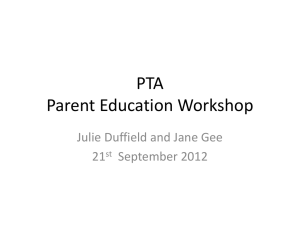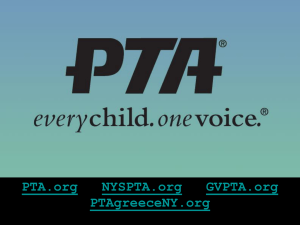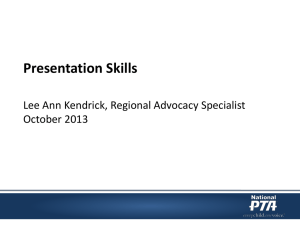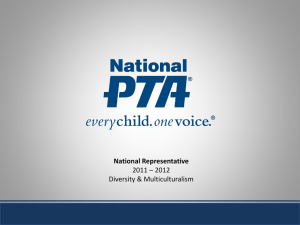National PTA, 2010 © National PTA, 2010
advertisement
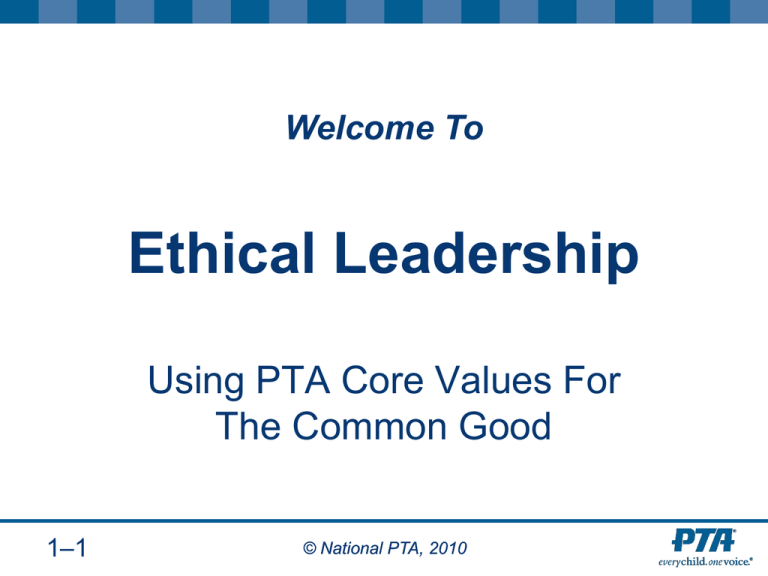
Welcome To Ethical Leadership Using PTA Core Values For The Common Good 1–1 © National PTA, 2010 Welcome to Ethical Leadership, a course that will help you do “what ought to be done” in the realm of handling PTA resources and personal interaction, and equip you to better advance the mission and purposes, and vision of the PTA (Local, State, and National). –2– © National PTA, 2010 Objectives After completing this course you will have: • • Viewed the current National PTA mission and purposes; vision; values; National PTA Basic Policies; and a generic PTA “Code of Ethics.” Explored ethical dilemmas that might present in your involvement with PTA using the “case study” method and identified an ethical course of action in each. 1–3 © National PTA, 2010 What Is “Ethics?” • As suggested by Aristotle (in his Nicomachean Ethics) and echoed and amplified by many others, Ethics deals with the question “What ought to be done?” Ludovici Collection. Photographer: Marie-Lan Nguyen. • If the answer were “common sense,” then theft, child abuse, discrimination, and the like would not occur, and a training program like this would not be needed. –4– © National PTA, 2010 What Do These Headlines Have In Common? • • Each headline has an identification with the PTA Each headline reflects some type of lapse in ethics –5– © National PTA, 2010 Potholes On The Road To Ethical Decisions –6– © National PTA, 2010 A General Principle: The Golden Rule/Ethic Of Reciprocity There is no better guide to the conscience than the "Golden Rule,“ and its precepts are so simple that any mind can grasp them. Alice McLellan Birney — PTA co-founder –7– © National PTA, 2010 The PTA Triple Filter Is It Legal? Does It Follow PTA Policies (Local, Council/District, State, National)? Does It Advance PTA's Mission And Purposes? Result = Decisions That Are Ethical In The PTA Context –8– © National PTA, 2010 Is It Legal? • • Most of us understand what’s illegal. For example, stealing money. In addition to theft, there are other ways you may get into legal trouble (criminal and/or civil): – – – – – –9– Compounding a felony and misprision of a felony Fraud Libel/Slander Negligence Child abuse © National PTA, 2010 Even If It Is Legal • Actions which may not be technically illegal in a volunteer environment do not necessarily advance the PTA Mission and Purposes, and so in the PTA context would be ethically dubious: – – – – –10– Favoritism Private agenda Autocratic leadership style Tobacco use or consumption of alcohol at a PTA-sponsored public event where children or youth are present © National PTA, 2010 Does It Follow PTA’s “Policies?” • • • • Local and State PTAs set their own Local and State policies, bylaws, codes of ethics and codes of conduct. This course presents National PTA Basic Policies and Standards of Affiliation Your Local and State PTAs probably have their own policies, bylaws, standing rules, codes of ethics and conduct which you should learn, and conduct your affairs consistent with. Contact your State office for a copy of your State policies, bylaws, standing rules, codes of ethics and conduct. –11– © National PTA, 2010 National PTA Basic Policies g. The a. b. c. d. e. f. Upon No The Notwithstanding part organization organization theofdissolution the netany shall shall or earnings members of other work work be thisnoncommercial, of provision organization, with tothe in promote the their organization schools ofofficial these the after nonsectarian, health and capacities articles, paying shalland inure or and community welfare to the adequately shall the organization nonpartisan. not, benefit ofdirectly children to providing of, provide shall or orand be indirectly, for not quality distributable youth, the carry debts education participate and on shall any and to, its other obligations for seek or members, all intervene activities to children promote of the (in not and youth, collaboration directors, permitted organization, any way, and including trustees, toshall be among thecarried seek remaining the officers, parents, topublishing on participate (i)or assets by schools, other anorshall organization inprivate distributing the and be decision-making the distributed persons community of exempt except to The complete PTA Bylaws document process at that from one Statements) large. the or federal more organization establishing income in nonprofit anyNational political tax shall school funds, under be campaign policy, foundations, authorized Section recognizing on 501(c)(3) and behalf or organizations empowered that of, of can the or theinbe to downloaded from National PTA website www.pta.org legal pay Internal that opposition reasonable have responsibility Revenue established to, any compensation Code candidate tothe make their or (ii) tax-exempt decisions for by for public an services organization, has office, status been rendered, or under delegated devote Section and to (Microsoft Word to view). by thethan make contributions 501(c)(3) more payments people ofanthe to insubstantial towhich Internal and boards distributions are Revenue of deductible education, partrequired of in Code itsfurtherance activities under State and Section education whose toof attempting the authorities, 170(c)(2) purposes to influence of set are and legislation the forth in Internal Local accordance in Article education byRevenue propaganda IIwith hereof. authorities. those Code. or ofotherwise. National PTA. Click to skip to next slide –12– © National PTA, 2010 A PTA Code of Ethics • Many State and Local PTAs have Codes of Ethics and Codes of Conduct. An Internet search of the terms “PTA” and “Code of Ethics” will turn up many examples. –13– © National PTA, 2010 Does It Advance PTA's Mission And Purposes? • • • The final “Triple Filter” question is “Does It Advance The PTA Mission And Purposes?” The PTA Mission And Purposes, Vision, and Values can be located online on the PTA website at: http://www.pta.org/1162.asp We will quickly review these items in the course frames that follow. –14– © National PTA, 2010 The PTA Mission The PTA Mission is the overall purpose of PTA. • A powerful voice for all children, • A relevant resource for families and communities, and • A strong advocate for the education and well-being of every child. –15– © National PTA, 2010 The PTA Purposes • • • • • To promote the welfare of the children and youth in home, school, community, and place of worship. To raise the standards of home life. To secure adequate laws for the care and protection of children and youth. To bring into closer relation the home and the school, that parents and teachers may cooperate intelligently in the education of children and youth. To develop between educators and the general public such united efforts as will secure for all children and youth the highest advantages in physical, mental, social, and spiritual education. –16– © National PTA, 2010 The PTA Vision • The PTA Vision is what the future will look like if PTA accomplishes its mission: Making every child's potential a reality. –17– © National PTA, 2010 PTA Values The PTA Values are what the PTA stands for: • Collaboration: We work in partnership with a wide array of individuals and organizations to accomplish our agreed-upon goals. • Commitment: We are dedicated to promoting children’s health, well-being, and educational success through strong parent, family, and community involvement. • Accountability: We acknowledge our obligations. We deliver on our promises. –18– © National PTA, 2010 PTA Values (Continued) • • • Respect: We value our colleagues and ourselves. We expect the same high quality of effort and thought from ourselves as we do from others. Inclusivity: We invite the stranger and welcome the newcomer. We value and seek input from as wide a spectrum of viewpoints and experiences as possible. Integrity: We act consistently with our beliefs. When we err, we acknowledge the mistake and seek to make amends. –19– © National PTA, 2010 National Standards For Family-School Partnerships • • • PTA, working with leading experts on parent involvement and school-community partnerships, has updated its National Standards for Parent/Family Involvement Programs to reflect recent research and improve parent and community involvement practices. The focus has been shifted from what schools should do to involve parents to what parents, schools, and communities can do together to support student success. To reflect this change, the standards have been renamed the National Standards for Family-School Partnerships. –20– © National PTA, 2010 National Standards For Family-School Partnerships Standard The complete 1: Communicating 6: 5: 4: 3: 2: Welcoming Collaborating Sharing Speaking Supporting document power upstudent all isfor with available families — effectively every Families community success child into online — and the — —Families — at: Families school Families school Families staff and are and and community are empowered school http://www.pta.org/Documents/National_Standards.pdf equal staff partners — collaborate continuously engage to Families be advocates inindecisions regular, are with collaborate active community fortwo-way, that their participants affect to own support members meaningful children and in other students’ the to and life of the school, connect families children, learning communication and students, and to and ensure together healthy about feel families, that welcomed, development inform, student students and influence, learning. staff valued, are both to treated expanded and at home create connected fairlyand learning and policies, athave to each other, opportunities, practices, access school, to and learning and to have community school programs. regular opportunities staff,opportunities services, and tothat what and willto students civic support strengthen participation. are theirtheir learning andand success. knowledge doing skills in to class. do so effectively. Click to skip to next slide –21– © National PTA, 2010 Case Studies • • Each case study shows a situation, and several possible actions to evaluate For each case, apply the "triple filter." Ask yourself: – Is it legal? – Does It Follow PTA's Policies? – Does It Advance PTA's Mission and Purposes? –22– © National PTA, 2010 Conclusion Always do right. This will gratify some people and astonish the rest. Mark Twain –23– © National PTA, 2010 Summary • • Ethical Leadership has been designed to help you do “what ought to be done” handling PTA resources and personal interaction, and to equip you to better advance the mission, vision, and purposes of the PTA. Now that you have completed this course you have: – Viewed the current National PTA mission, vision, and purposes; National PTA Basic Policies; and a generic PTA “Code of Ethics.” – Explored ethical dilemmas that might present in your involvement with PTA using the “case study” method to identify an ethical course of action in each. –24– © National PTA, 2010 National PTA® 1250 N. Pitt Street Alexandria, VA 22314 800.307.4782 Connect with National PTA® www.pta.org Twitter | Facebook | YouTube | Fotki 1–25 © National PTA, 2010
